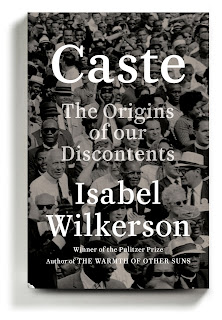Collective Conviction in Isabel Wilkerson's "Caste"
What I thought would be a modern reiteration of the Communist Manifesto touched upon a different, albeit similar kind of social stratification, one far more rooted in racial and ethnic distinctions. Isabel Wilkerson’s Caste: The Origins of Our Discontents offers a provocative analysis of the racial caste system that is deeply entrenched throughout American society. Drawing from other caste societies such as Nazi Germany and Hindu India, Wilkerson displays how pervasive and nearly inescapable the shackles of caste truly are for both minorities and whites in the United States.
From the moment African slaves
were brought to America and systematically dehumanized, the caste system came
into in existence. Even after the civil war and emancipation proclamation, the
dark legacy of slavery kept black Americans socially, economically, and
politically suppressed. This systemic discrimination carried on into the Civil
Rights era and beyond, in increasingly subtle ways. Like it or not, argues
Wilkerson, we have all internalized this social hierarchy based on race and
allowed it to continue into the present day.
Wilkerson’s book is not an easy
read. She glosses over no details in the mistreatment of black Americans and
other ethnic minorities. The stories of hardship and discrimination that she
shares are often riddled with gruesome acts of violence, accounts of
intergenerational trauma, and the unapologetic embrace of injustice by those in
the white class. Human suffering is on full display in the American caste
system, and to confront this as a reader can leave one feeling angered,
disgusted, and in despair.
As mentioned earlier, the
intergenerational nature of the American caste system is emphasized throughout
the book. One comes to realize that black Americans of today are the
descendants of survivors, individuals who had to overcome profound difficulty
and suffering so that their families may live to see the future, with all its
uncertainty and hardship. The sacrifices and persevering spirit of these
individuals continually amazes, while also serving as a poignant reminder that
the bloodstains of the past cannot be easily erased, despite the many
achievements have been made in the fight for equality.
Wilkerson even shares her own
stories as a victim of the American caste system. Being a black woman forced
her confront prejudice and discrimination throughout her life, despite her
status as an esteemed writer and journalist. Her vulnerability in sharing these
stories does not go unnoticed, and one cannot help but feel her pain in the
words that she writes. Some of the instances occurred years ago, and yet still
linger with her to this day. Wilkerson makes it abundantly clear that the narrow-minded
lens of caste does not see individuals for the content of their character, but rather
the color of their skin.
The book’s in-depth exploration
of the American caste system can prompt indignation at our country’s consistent
inability to apply the concept of “liberty and justice for all.” But
Wilkerson urges readers to see beyond the despair that the caste system so
often tries to impose. Instead, she challenges her audience to critically
assess how we remember and respond to the grim legacy of the American caste
system. Will we continue allowing it to pervade our societal subconscious? Or
will we educate, re-evaluate, and pursue ways to reconcile and make amends? The
caste system is an undeniable and inescapable part of our past, but it need not
define our future.


Comments
Post a Comment